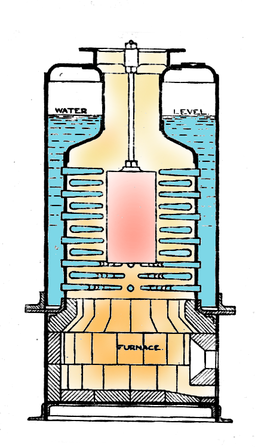
A thimble tube boiler is a form of steam boiler, usually provided as an auxiliary boiler or heat-recovery boiler. They are vertical in orientation and would be considered a form of water-tube boiler.

A thimble tube boiler is a form of steam boiler, usually provided as an auxiliary boiler or heat-recovery boiler. They are vertical in orientation and would be considered a form of water-tube boiler.
The characteristic feature of this boiler are its 'thimble tubes'. These are short horizontal water tubes, closed at one end and tapered. They are thus similar to the field-tube boiler, which also uses single-ended closed tubes, but with important differences. The field-tube boiler uses downward-pointing vertical tubes and these also have an internal tube. This extra tube segregates the flow into a central cold downcomer and an upwelling outer flow of heated water and boiling steam. In the thimble tube, there is no such segregation and so boiling is a random process with flow back and forth along the tube.
The thimble tube boiler was developed after experiments by Thomas Clarkson and is still firmly associated with the Clarkson firm as a maker. [1] Other makers also produced them in smaller quantities. Niven of Newcastle upon Tyne were granted a patent in 1935, some decades after Clarkson began manufacture, for a relatively small improvement. [2]
As boiling is random, the boiler is limited in both its evaporative capacity and also its maximum furnace temperature. However the boiler can offer a large heating area in a small volume, costs comparatively little to construct relative to this area and is also accessible for cleaning. Accordingly, the boiler was not generally used as a primary steam power generator but typically as a donkey boiler supporting secondary or hotel services, particularly on-board ships.
The boilers were also mostly used as heat-recovery boilers, from the exhausts of large marine diesel engines, as these operated at a lower temperature than a direct-fired boiler. Some were equipped as composite boilers, heated by exhaust gases when under way or with oil-firing when in port.
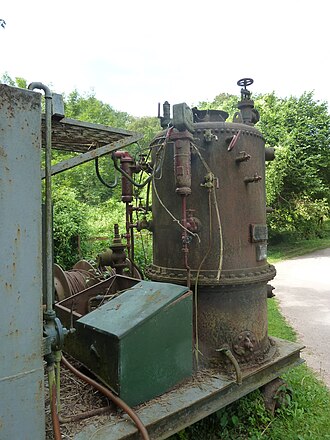
Thimble tube boilers require horizontal tubes to permit their variable boiling flow, thus the boiler shells are constructed as vertical boilers. The majority have a large vertical central flue, with the thimble tubes protruding into it from a surrounding water jacket. These thimble tubes are formed by deep drawing of steel – a process that was not available in Victorian times, but that became a cheap means of production once available. Hot gas enters from beneath and exits from the top of the boiler. To improve gas flow over the tubes, a series of horizontal disks are lowered into the central space on a rod or chain, forcing gas flow radially outwards, over the tubes. [2] Cleaning these inward-pointing thimbles could be difficult. A 1954 patent by Clarksons describes a boiler shell with a sliding shutter on the outside to access the central flue. [3]
An alternate form had a central water tank with outward-pointing thimbles, surrounded by a dry sheetmetal casing. These were somewhat less efficient owing to heat losses through the casing, but were more accessible for tube cleaning. These were used for industrial heat recovery, with dirty flue gases. A minor drawback to the thimble tube is that although the outer fire side of the thimble is easy to clean, the inner water-side is difficult or impossible. Any scale build-up here must be removed at 'eggshell thickness' before it becomes impossible. [4]
Where the boiler was arranged for composite firing, the central flue version was used with oil firing. Fired boilers sometimes included vertical water-tubes of more conventional form as well, to improve circulation. [1] There could even be cross-tubes, as for the common vertical cross-tube boiler. [3] A common form for ships had both inner and outer flues, with separate gas circuits for each; the inner used for oil firing and the outer for exhaust heat-recovery. [5] This avoided problems of exhaust blowback into the oil-fired flue. Another composite form for ships used two boilers: one of minimal form with a central flue, used as a silencer economizer for the diesel engines, and another as a purely oil-fired central flue boiler. [6] The economizer was used with pumped circulation (as it was usually mounted high up) as a feedwater heater. This system was used where a large amount of steam was required even when in port, such as for heated cargoes like banana boats and passenger liners.
A typical boiler could be 7 feet (2.1 m) diameter and 18 feet (5.5 m) high
The major use was from the first diesel motorships, through to the present day. Many ship systems, from steam winches and cranes through to domestic heating and the heating of bunker oil as a fuel oil, use steam, produced by such an auxiliary boiler.
One rare use of the thimble tube boiler as a directly fired power generator was an experiment fitting to Leyland steam wagons in 1920. [7] [8] This coke-fired boiler was 2 feet (0.61 m) diameter by 2.75 feet (0.84 m) height and has 128 tubes. [7] The following year, Clarkson exhibited their own 3 ton steam wagon in the Commercial Motor exhibition at Olympia. [9]

A boiler is a closed vessel in which fluid is heated. The fluid does not necessarily boil. The heated or vaporized fluid exits the boiler for use in various processes or heating applications, including water heating, central heating, boiler-based power generation, cooking, and sanitation.

A furnace, referred to as a heater or boiler in British English, is an appliance used to generate heat for all or part of a building. Furnaces are mostly used as a major component of a central heating system. Furnaces are permanently installed to provide heat to an interior space through intermediary fluid movement, which may be air, steam, or hot water. Heating appliances that use steam or hot water as the fluid are normally referred to as a residential steam boilers or residential hot water boilers. The most common fuel source for modern furnaces in North America and much of Europe is natural gas; other common fuel sources include LPG, fuel oil, wood and in rare cases coal. In some areas electrical resistance heating is used, especially where the cost of electricity is low or the primary purpose is for air conditioning. Modern high-efficiency furnaces can be up to 98% efficient and operate without a chimney, with a typical gas furnace being about 80% efficient. Waste gas and heat are mechanically ventilated through either metal flue pipes or polyvinyl chloride (PVC) pipes that can be vented through the side or roof of the structure. Fuel efficiency in a gas furnace is measured in AFUE.

A combined cycle power plant is an assembly of heat engines that work in tandem from the same source of heat, converting it into mechanical energy. On land, when used to make electricity the most common type is called a combined cycle gas turbine (CCGT) plant. The same principle is also used for marine propulsion, where it is called a combined gas and steam (COGAS) plant. Combining two or more thermodynamic cycles improves overall efficiency, which reduces fuel costs.

A fire-tube boiler is a type of boiler in which hot gases pass from a fire through one or more tubes running through a sealed container of water. The heat of the gases is transferred through the walls of the tubes by thermal conduction, heating the water and ultimately creating steam.

A high pressure watertube boiler is a type of boiler in which water circulates in tubes heated externally by the fire. Fuel is burned inside the furnace, creating hot gas which boils water in the steam-generating tubes. In smaller boilers, additional generating tubes are separate in the furnace, while larger utility boilers rely on the water-filled tubes that make up the walls of the furnace to generate steam.
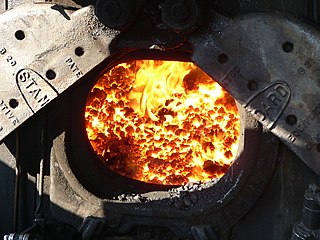
In a steam engine, the firebox is the area where the fuel is burned, producing heat to boil the water in the boiler. Most are somewhat box-shaped, hence the name. The hot gases generated in the firebox are pulled through a rack of tubes running through the boiler.

A heat recovery steam generator (HRSG) is an energy recovery heat exchanger that recovers heat from a hot gas stream, such as a combustion turbine or other waste gas stream. It produces steam that can be used in a process (cogeneration) or used to drive a steam turbine.

A thermal power station is a power station in which heat energy is converted to electricity. Typically, heat is used to boil water in a large pressure vessel to produce high-pressure steam, which drives a steam turbine connected to an electrical generator. The low-pressure exhaust from the turbine passes through a steam condenser and is recycled to where it was heated. This is known as a Rankine cycle. Natural gas can also be burnt directly in a gas turbine similarly connected to a generator.
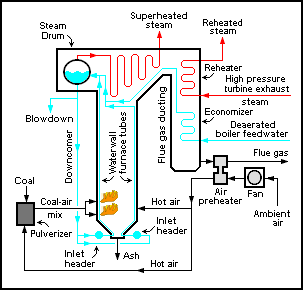
An air preheater is any device designed to heat air before another process (for example, combustion in a boiler With the primary objective of increasing the thermal efficiency of the process. They may be used alone or to replace a recuperative heat system or to replace a steam coil.
Economizers, or economisers (UK), are mechanical devices intended to reduce energy consumption, or to perform useful function such as preheating a fluid. The term economizer is used for other purposes as well. Boiler, power plant, heating, refrigeration, ventilating, and air conditioning (HVAC) uses are discussed in this article. In simple terms, an economizer is a heat exchanger.

A turboexpander, also referred to as a turbo-expander or an expansion turbine, is a centrifugal or axial-flow turbine, through which a high-pressure gas is expanded to produce work that is often used to drive a compressor or generator.

Recovery boiler is the part of kraft process of pulping where chemicals for white liquor are recovered and reformed from black liquor, which contains lignin from previously processed wood. The black liquor is burned, generating heat, which is usually used in the process of making electricity, much as in a conventional steam power plant. The invention of the recovery boiler by G.H. Tomlinson in the early 1930s was a milestone in the advancement of the kraft process.

A boiler or steam generator is a device used to create steam by applying heat energy to water. Although the definitions are somewhat flexible, it can be said that older steam generators were commonly termed boilers and worked at low to medium pressure but, at pressures above this, it is more usual to speak of a steam generator.

A waste heat recovery unit (WHRU) is an energy recovery heat exchanger that transfers heat from process outputs at high temperature to another part of the process for some purpose, usually increased efficiency. The WHRU is a tool involved in cogeneration. Waste heat may be extracted from sources such as hot flue gases from a diesel generator, steam from cooling towers, or even waste water from cooling processes such as in steel cooling.
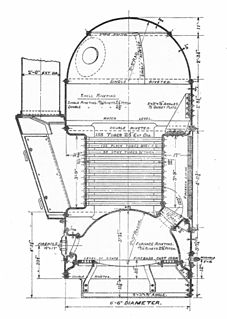
A vertical boiler with horizontal fire-tubes is a type of small vertical boiler, used to generate steam for small machinery. It is characterised by having many narrow fire-tubes, running horizontally.

Yarrow boilers are an important class of high-pressure water-tube boilers. They were developed by Yarrow & Co. (London), Shipbuilders and Engineers and were widely used on ships, particularly warships.
Boilers for generating steam or hot water have been designed in countless shapes, sizes and configurations. An extensive terminology has evolved to describe their common features. This glossary provides definitions for these terms.
A Field-tube boiler is a form of water-tube boiler where the water tubes are single-ended. The tubes are closed at one end, and they contain a concentric inner tube. Flow is thus separated into the colder inner flow down the tube and the heated flow upwards through the outer sleeve. As Field tubes are thus dependent on thermo-syphon flow within the tube, they must thus always have some vertical height to encourage the flow. In most designs they are mounted near-vertically, to encourage this.
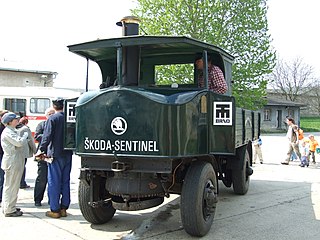
The Sentinel boiler was a design of vertical boiler, fitted to the numerous steam waggons built by the Sentinel Waggon Works.

Three-drum boilers are a class of water-tube boiler used to generate steam, typically to power ships. They are compact and of high evaporative power, factors that encourage this use. Other boiler designs may be more efficient, although bulkier, and so the three-drum pattern was rare as a land-based stationary boiler.
| Wikimedia Commons has media related to Clarkson thimble tube boilers . |